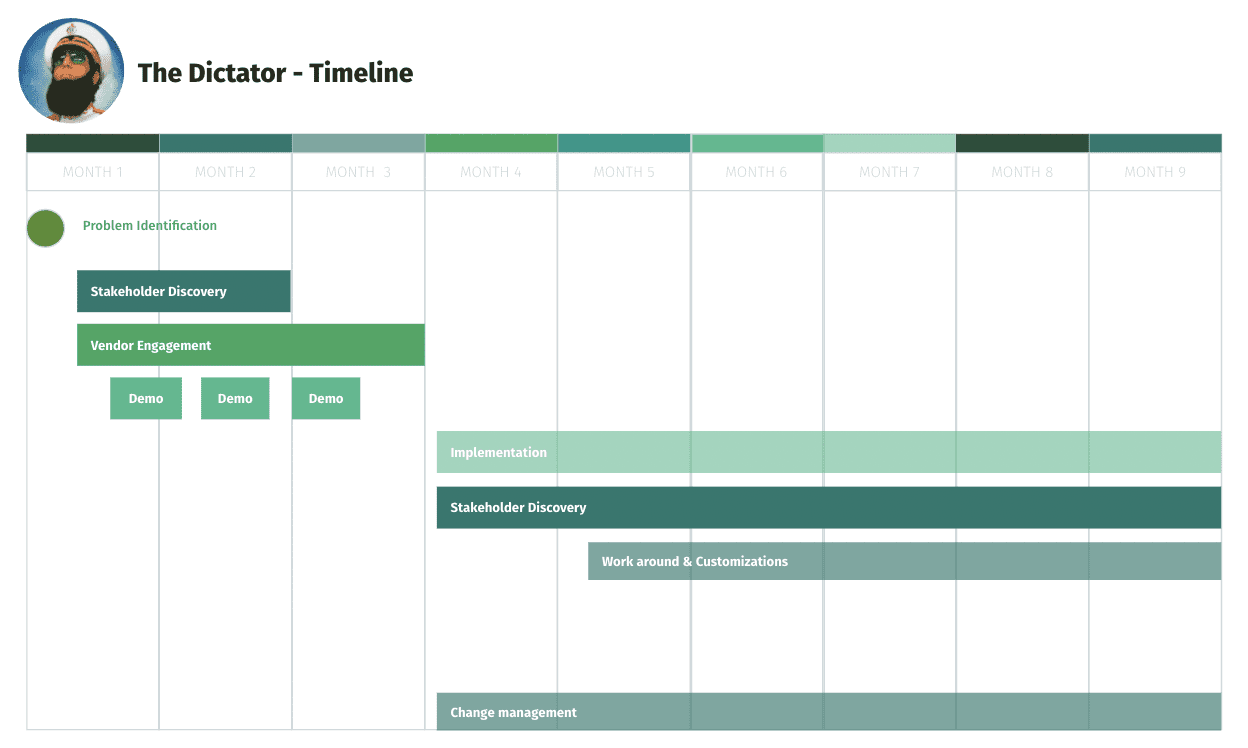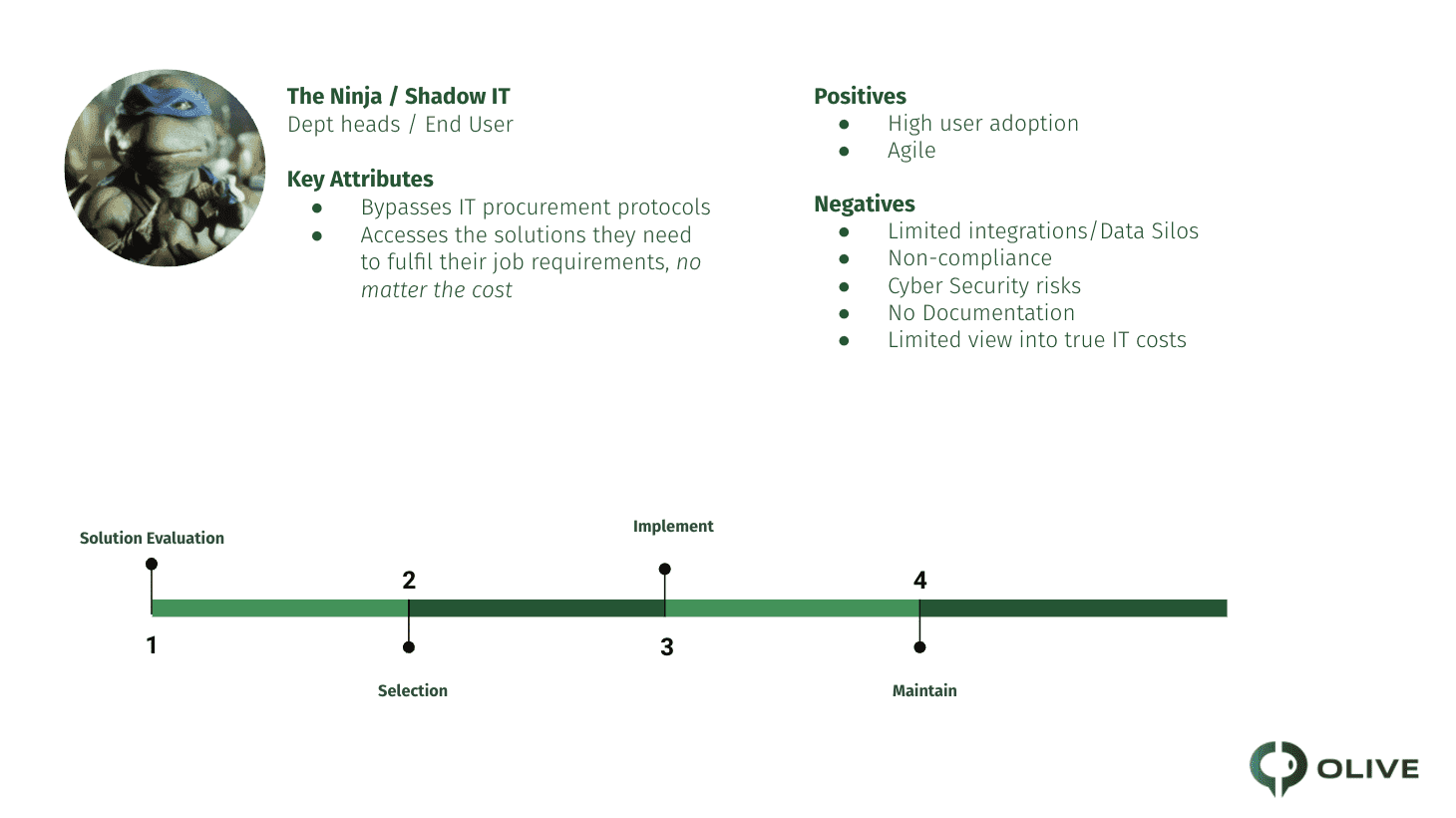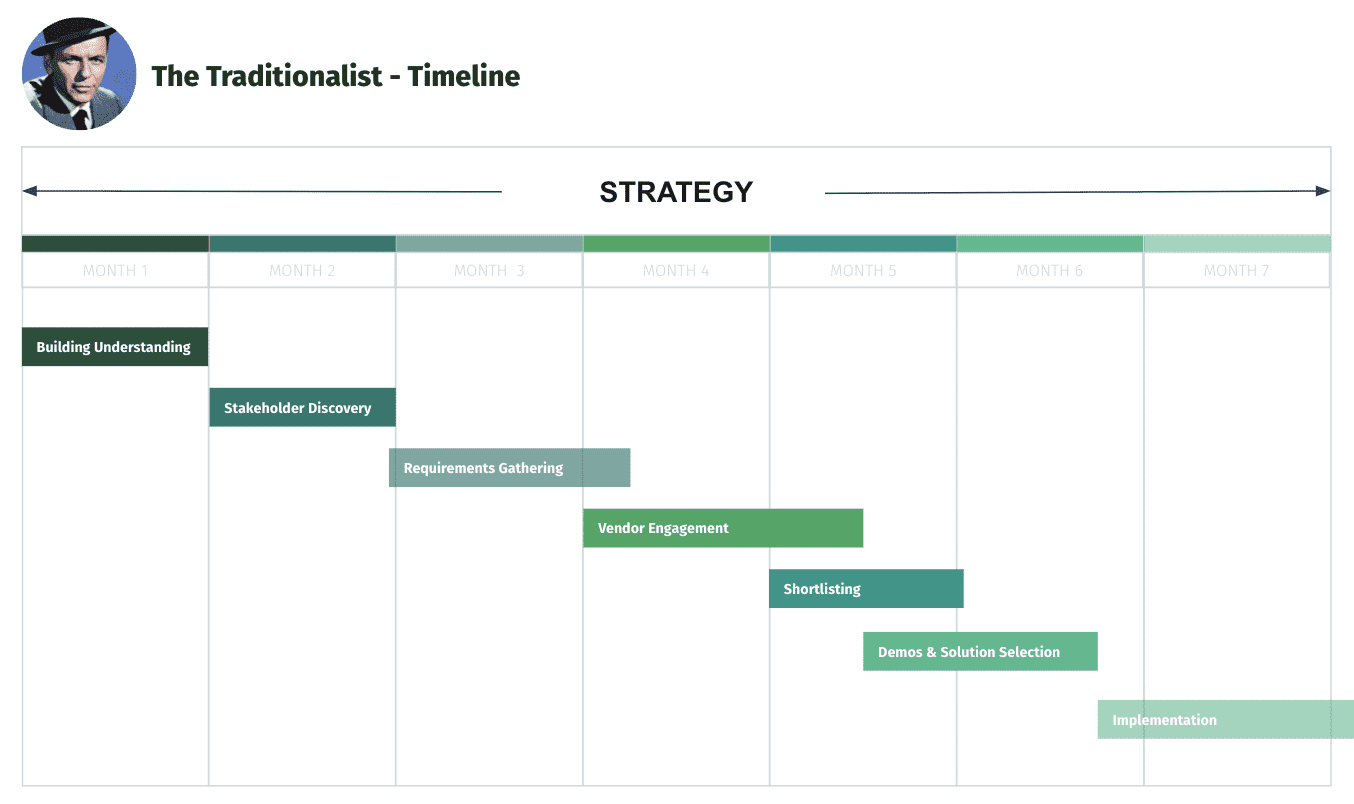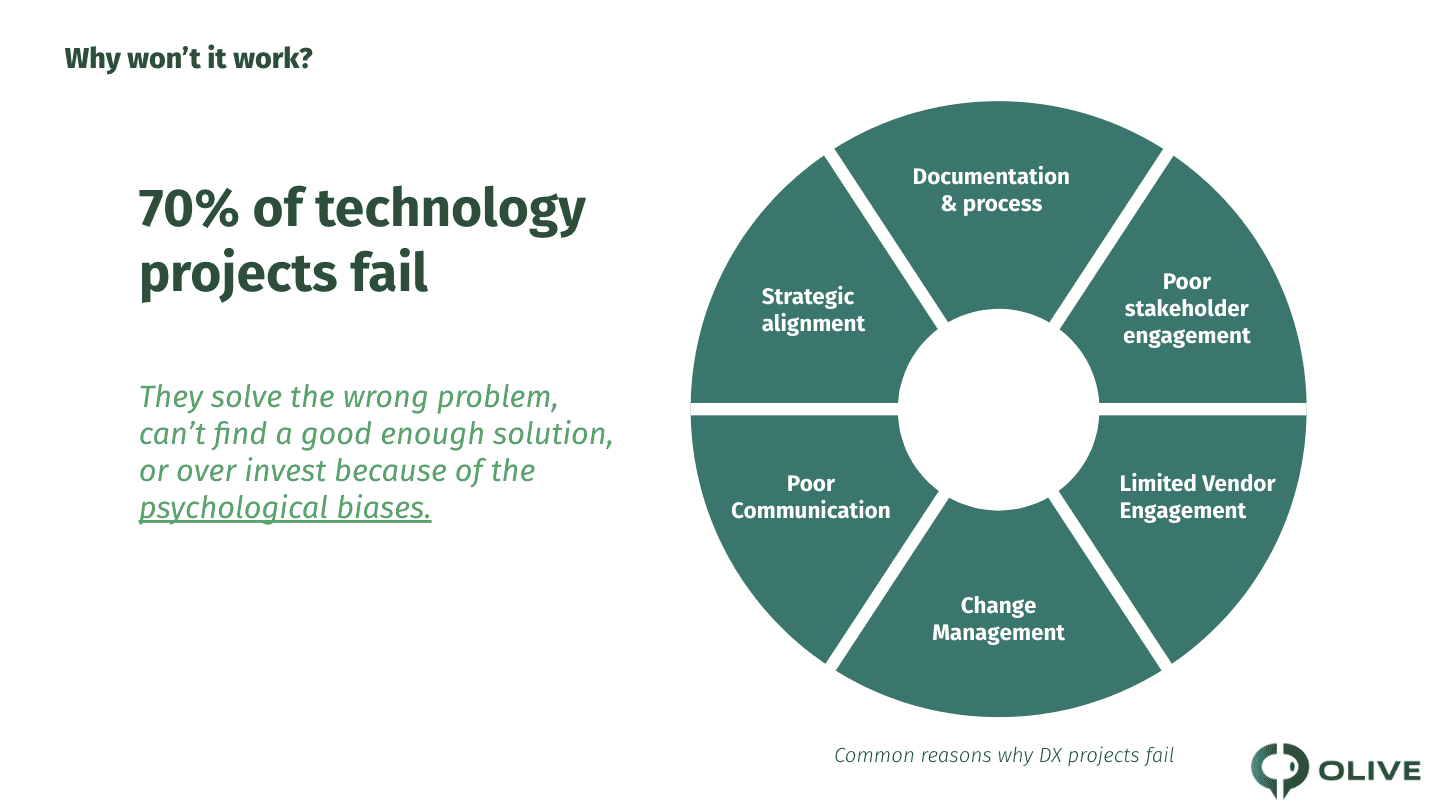Streamline the Enterprise Software Selection Process to Find Solutions That Drive Digital Transformation
Navigating digital transformation has become vital as companies strive to keep pace with ever-changing technology demands. While numerous organizations aspire to revolutionize their business operations through technology, only a few possess the necessary readiness and knowledge to effectively embark on the journey of digital transformation.
Here, we will walk you through how to get digital transformation right and find the solutions that deliver results. We will also give you an overview of companies’ common mistakes in procuring software and how to avoid them.
How to Begin Your Digital Transformation Journey
One of the most confusing aspects of getting started with any digital transformation initiative is knowing where to start. It can be hard to determine where all your resources should go, or even if you’re making smart investments. Digital transformation is not as simple as buying the top-rated solution off the shelf. True transformation requires deep thought into the business requirements and ensuring whatever the solution, it meets the needs of all relevant stakeholders.
Knowing how to drive digital change is becoming more important than ever for delivering business value.
Digital Transformation vs. Business Transformation
You will often see businesses confuse these two terms and use them interchangeably, but let’s set the record straight:
Business transformation is looking at your business processes first to identify the inefficiencies and redundancies within your business. Optimizing and changing those processes to deliver the intended business outcomes. Often this will include some aspect of technology, but that is not always necessary. We can transform the business without tech.
One basic example; changing the ordering process to make it more efficient by moving printers closer to pickers to eliminate time waste due to unnecessary movement.
Digital transformation is the process of finding and implementing tools that will increase an organization’s speed, agility, and data-driven decision-making capability, among other things.
Usually, some aspects of business transformation are included in each digital transformation initiative. For example, new technology usually requires some change to current processes or a new technical skill set to take full advantage of the new solution.
Digital transformation is a never-ending journey, but that doesn’t mean you have to do it on foot and blindly follow others. There is an easier mode of transportation. Before we explore this, let’s look at the three most common ways it is done today.
The Three Ways Digital Transformation Is Done Today
Let’s look at the three most common approaches to digital transformation and technology evaluations organizations use today. You may find that you have been part of a technology project and have experienced one of these approaches. To add some color, we have given each leader a character to understand the approach better.
1. The Dictator

This image might make you laugh, but if you have been involved in tech projects, chances are you have brushed up against this character. These leaders will approach a project at a very high level with limited knowledge or understanding of the stakeholder needs or business processes. They are confident and self-assured, and based on a basic understanding of the high-level business functions or needs; they will offer solutions that have worked at other companies in the past. This may mean only demoing a few solutions or going straight to a single solution.
Whether executives or consultants, the Dictator often bases these suggestions on experience. Let’s be real. This is why you hired them in the first place, for their experience.
However, if experience matters, then shouldn’t we learn from the countless failed IT implementations – one size does not fit all.
From our perspective, there are some key concerns with this type of approach:
- Limited options – If industry leaders were the best at everything – there would be no such term as “Best of Breed.”
- Limited stakeholder engagement – If you don’t know about the problem, how can you solve it?
- Personal bias towards their objectives & needs – IT may want to simplify the IT stack meaning additional solutions are not welcomed, do more with less.
With that in mind, let’s look at the basic timelines for this approach.

In this example timeline, this type of approach intends to make decisions faster so that you can deliver business value sooner. Yet, this is where the problem lies. This approach may lead to a faster decision, but it is long way from delivering actual business value. Often, that destination is never reached.
Here is why: After vendor selection, the broader stakeholders get involved, and pandora’s box opens. During implementations, stakeholders’ needs, that were never discussed as part of the evaluation, are identified. Out of necessity, the implementation team starts to figure out workarounds, customizations (added cost), or even worse, make a promise to resolve later. At the same time, the business continues to rely on legacy systems for certain portions of the process.
Implementations can fail for many reasons, but poor change management is often overlooked. When stakeholders begin to see that the project never considered their needs, you now have people pushing against this solution. You want stakeholders to be champions of the new solution, but in this case, you turn them into detractors, which leads to poor user adoption and eventual failure.
Please note, not all projects that use this approach fail, but this approach often adds unnecessary risk of failure and additional unplanned costs. So how can you mitigate these risks? It’s as simple as facilitating early stakeholder engagement and input.
2. The Ninja / Shadow IT

This approach, we named The Ninja. The Ninja is quick, efficient, and do their work in secret, often referred to as “Shadow IT”. These folks are trying to get stuff done by finding tools that work for them. They are looking for a new tool to deliver greater efficiency to their team or ease user experience. No matter the reason in this approach – IT procurement protocols are bypassed, leading to data silos, redundant systems, and unnecessary cybersecurity risks.
From a user perspective, IT oversight and stringent government policies are designed to protect the organization – not necessarily to address users’ challenges at the workplace which may point to a bigger issue of company culture or organizational structure that may also need to be addressed. For now, let’s take a look at the Ninja’s timeline.

At a glance, this approach looks to be very efficient. Limited engagement, discovery, and requirements analysis, and quick implementation. Doing what needs to be done to deliver business value.
This approach sounds great, but unfortunately, we come back to the same issues as the Dictator – limited understanding of stakeholder needs. The shadow team/ Ninja never considered the wider stakeholders’ needs in this approach. Not having insight at the organization level can lead to data silos, redundant systems, and unnecessary cybersecurity risks.
In addition, ongoing support & maintenance will require developing a relationship with an external party (additional costs & complexity) or relying on internal IT. Regarding internal IT, the same change management principles apply here. IT stakeholders realize that the project leaders never consulted them or any of their requirements in the selection process. They push back (for valid reasons) and are less inclined to support the decision.
While efficient in the short term, this approach often leads to failure in the long term due to reasons such as:
- Redundancy – New Solution is shelved in favor of a less capable solution that works or integrates better at an organizational level.
- Loss of champions – The original champions or decision-makers leave, and no one recalls why this solution is being used.
- No internal product expertise to support or maintain.
We’re not saying that this approach always fails or can’t deliver business value. Anyone can understand why this approach is taken. When end-users feel unheard, when KPIs demand a higher result, or the organizational culture does not support innovation, or when the transformation process itself is a nightmare, people will circumvent the status quo.
At Olive, we believe digital transformation leaders should utilize an agile approach to solution selection, but not at the cost of ignoring organizational needs and objectives or end-user needs.
Uncovering Enterprise Shadow IT: The Elephant in the Room
3. The Traditionalist

The Traditionalist’s approach is something many are familiar with – also known as the traditional waterfall/hybrid approach to technology procurement projects.
This digital transformation journey starts at the organizational level (top-down). Everyone agrees to the organization’s strategic direction and then determines what work needs to be done to achieve the set objectives as a leadership team. Prioritizing the projects that will deliver the largest measurable results towards that objectives.
In this approach, the process requires documentation, stakeholder engagement, and approvals throughout to ensure alignment across the organization.
The process helps to eliminate many of the risks discussed in the other two approaches. However, this approach has its risks;
- Time – There is immediate pain in the business and known benefits of change, which always puts a sense of urgency to these initiatives. This approach takes the longest time but also provides the most thoroughness.
- Resource Intensive – Organizations will often allocate a percentage of resources to this approach, meaning there is also a higher opportunity cost associated.
- Stakeholder burnout – A problem that arises from a combination of resourcing and time. The timeline drags on due to; long meetings required to document the process, gather requirements, ranking requirements, evaluate vendors, conduct product demos, etc. With no end in sight, the stakeholders begin to experience burnout, lose interest, and are no longer productive project team members. Worst-case scenario, they are no longer invested in the project’s success.
Let’s take a look at the Traditionalist’s timeline.

At Olive, we believe the steps outlined here are the best way to reduce the risk associated with technology projects. However, we acknowledge that this approach leads to much longer timelines since there is more process, documentation, and oversight.
That’s the number one issue with this approach, the sheer amount of time it takes before you have selected a solution and start to implement it. This is also the number one reason why organizations tend to skip over steps, jump straight into demos, or avoid crucial pieces of the process that produce success later.
History teaches us that planning and due diligence should not be disregarded to save time. The upfront effort will save you countless resources, painful and expensive workarounds, customization costs and will often eliminate most of the risks associated with selecting & implementing new technologies.
Why do Digital Transformation Projects Fail?
It’s mind-blowing to think that 70% of technology fail for many reasons we have already discussed.
- Red tape – documentation and process can kill innovation, and too little can leave you open to the risk of failure
- Not enough time or resources allocated
- Only looking at a limited # of vendors or worse, just one
- Change management – Deliver a solution to the user without input from the user.
- Poor communication and alignment leads to low user adoption & overall failure
- And the biggest reason of all – poor stakeholder engagement.
Poor stakeholder engagement is the number one reason why digital transformation efforts fail.

When you look at the 3 approaches to digital transformation, stakeholder engagement is at either end of the spectrum.
- The Traditionalists will include the most stakeholders, but the process is long, leading to stakeholder burnout and, thus, poor engagement.
- The Dictator will involve minimal stakeholders, leading to misunderstood or completely missed needs.
- The Ninja’s number one concern is their internal team or department, not the entire organization, resulting in crucial missed needs.

What Happens When the Digital Transformation Project Fails?
Let’s look at an example of a failed digital transformation project and why it failed. In 2000, Nike underwent a $400 million upgrade to its supply chain and ERP systems, which resulted in $100 million in lost sales, a 20 percent stock dip, and a collection of class-action lawsuits.
Nike’s experience can teach us a valuable lesson. Why did this happen?
That’s right, poor stakeholder engagement. Nike never considered the users of the product itself (the planners) and their needs. They also did not engage with broader stakeholder group, which led to completely missing integration requirements.
That is why stakeholder engagement & collaboration is so critical.

What Happens When the Digital Transformation Project Succeeds?
In 2020, A&W Canada was tasked with finding a new BI tool for the billion-dollar company. The internal goal was to reduce manual effort across the internal organization and increase productivity.
Some of the issues A&W was facing;
24 different systems with data
- Data Silos & duplication of data
- Overuse of spreadsheets
- Integrations with other systems
A&W chose Olive to facilitate stakeholder engagement and collaboration across 7 teams with 50+ stakeholders.
The results
- Over 10,000+ hours of manual effort eliminated
- 99% User adoption within 3 months
Read the full case study here.
What’s the best way to navigate digital transformation?
What is the best approach to software selection for finding solutions that drive change?
You should follow up steps outlined in the traditionalist approach but make the process more agile and collaborative by using technology to eliminate any of the risk associated with the process itself. (Olive was built for this purpose)
Following the steps outlined in the traditionalist approach whilst facilitating excellent stakeholder engagement, drives results.
We’ve spent years figuring this out and implementing it into our product. Olive gives you a more agile way to run any digital transformation project, while eliminating the long, tedious timelines and documentation involved in the process. Let’s take a look at the Olive process in the short video below.
Accelerating Digital Transformation with AI (Artificial Intelligence)
As organizations strive to revolutionize their business operations through technology, one of the hottest trends in this transformative journey is the integration of Artificial Intelligence (AI). AI empowers organizations to increase their speed, agility, and data-driven decision-making capabilities.
By leveraging AI-powered tools and solutions, businesses can streamline processes, enhance efficiency, and unlock unprecedented insights from their data. The prominence of AI in digital transformation initiatives highlights its potential to drive meaningful change and propel businesses towards success in the modern era. With AI at the forefront, organizations can harness the power of technology to navigate the complexities of digital transformation and achieve remarkable outcomes.
Navigating Collaborative Digital Transformation with Confidence, Speed and Agility
Digital transformation has become a crucial undertaking for organizations striving to keep pace with evolving technology and drive meaningful change. However, many companies find themselves unsure of where to begin or how to navigate the complex process effectively.
To navigate digital transformation successfully, it is crucial to strike a balance between agility and stakeholder engagement. This is where Olive, an end-to-end digital transformation platform, comes into play. Olive offers an agile and AI-Powered collaborative solution, combining the thoroughness of the Traditionalist, the speed of the Ninja, and the confidence of the Dictator.
By leveraging Olive’s platform, organizations can streamline technology evaluations, enhance collaboration, and gain data-driven insights. Olive empowers stakeholders to actively participate in the transformation journey, ensuring that their needs are heard and integrated into the selection process. With Olive, organizations can accelerate their digital transformation initiatives and achieve meaningful results.
Embracing Digital Transformation
Embracing digital transformation is a never-ending journey, but with the right approach and tools, organizations can navigate the process confidently and drive positive change throughout their operations.
Olive’s agile approach helps streamline technology evaluations, increase collaboration and stakeholder engagement, and provide a data-driven and collaborative platform that gives you insights to help you find the solutions that will transform your business.
In short, Olive gives you the thoroughness of the Traditionalist, the speed of the Ninja with the confidence of the Dictator!





